Types of Sports and Related Injuries
Contact Sports Injuries
Sports with frequent contact between players, such as football, basketball and rugby, bring higher risk of injury to shoulder and lower limb. Some common types of injury include muscle sprain, ligament tear, soft tissue injury, bone fracture or dislocation.
Footaball Football players need to twist their knees and ankles towards different directions all the time. They may even stop or turn abruptly when running. All these will lead to a lot of sports injuries.
Football players need to twist their knees and ankles towards different directions all the time. They may even stop or turn abruptly when running. All these will lead to a lot of sports injuries.
Sudden stops harm the knees
Stopping abruptly, turning around in high speed or jumping to stop a ball may all harm the anterior cruciate ligament (ACL) in knee joint and cause a partial tear or a total tear, depending on the angle and force of the twist.
During the acute injury, usually pain is felt immediately around the knee and sometimes a popping sound can be heard. There may also be a feeling of dislocation of the knee joint. Shortly afterwards the injured ligament will bleed and there will be swelling. If the ligament is only partially torn, one may still walk unsteadily but with a total torn ligament, one will be too painful to walk or stand.
In one to two months' time, much pain will be gone. Moreover, the stagnated blood in the knee joints will be dispersed and the swelling will be subsided. One may still be able to lead a normal life without seeking treatment, but the knee may feel unstable when doing certain twisting motion, such as walking down staircases. It may also have occasional episodes of pain and swelling afterwards. Pain is more likely to occur when one exercises again after such injury. Knee joint will be dislocated easily, thus increases the chance of meniscus cartilage injury and lead to joint degeneration.
There are 60% chances of meniscus injury when an ACL tear occurs. Not only may the meniscus dislocate or break, there may also be cartilage fracture. Even posterior, medial and lateral collateral ligaments may be torn as well. Under intense strike, even stronger bones may break.
Ankle sprain
When playing football, one may have ankle sprains due to dribbling, stopping abruptly, being tackled or losing balance. In most cases lateral ligament would be injured, and sometimes there may even be bone fractures.
With a partial or complete tear of the lateral ligament, the ankle will be swollen, painful and unstable, thus recurring sprain is likely to happen. If swelling persists, there may be stiffness or calcification in the foot joint, which will lead to osteophytes (bone spur) that affects the flexibility of the ankle. In the end one's joint may even degenerate.
Basketball  Similar to football, basketball is a kind of sports that involves jumping, twisting and abrupt stopping, thus knee joints and ankles are facing the same risks. Upper limb injury happens as well, especially shoulders and fingers.
Similar to football, basketball is a kind of sports that involves jumping, twisting and abrupt stopping, thus knee joints and ankles are facing the same risks. Upper limb injury happens as well, especially shoulders and fingers.
Shoulder dislocation
When playing basketball, shoulders will unavoidably receive direct blows. Sometimes bone fracture may occur, especially when one falls or gets bumped. However, the most common injury is shoulder dislocation, causing by the attacking blows coming from front and back at the same time. It may also happen if there is a shoulder strike when someone tries to grab the ball from behind.
Shoulder dislocation must be handled with caution. Even if the shoulder is put back into place, a surgery should still be performed to stabilize the joint. Recurrent dislocations are likely to happen when the first incident is not managed properly. It is because the soft tissues around the shoulder will be injured as well. However, the self healing ability of the tissues is rather low, thus dislocation is very likely to occur when the shoulder is struck again.
Other than dislocation, the muscle groups in the shoulder may also be torn under the strike.
Acromion harmed by overhead activities
The repetitive overhead movement of shooting a basketball will lead to subacromial impingement, the situation which the acromion and the below muscle groups rub against each other. This will lead to ligament abrasion or even fracture
Initially, the subacromial area will be inflamed, swollen and painful. Without treatment, the ligament will be torn and causing the arm muscle to drop.
Mallet Finger
When catching a basketball of great force and high speed, one's fingers may easily be jammed. This may cause muscle sprain, joint dislocation or bone fracture, but the most common injury is ligament tear known as mallet finger. The injured finger will also be swollen and painful and one will have trouble straightening the tip of it.
Rugby Among all contact sports, traditional rugby is the one with the most significant physical impact force on players. All movements, including passing, catching, tackling and grounding involve full contact of players. Almost every muscle is being used, so basically one may have all sorts of sports injury from head to toe.
Among all contact sports, traditional rugby is the one with the most significant physical impact force on players. All movements, including passing, catching, tackling and grounding involve full contact of players. Almost every muscle is being used, so basically one may have all sorts of sports injury from head to toe.
Tackling leads to injury
Defend tactics such as shoulder tackling and pulling are frequently used in a rugby game and the force of such strikes is greater than those in football and basketball games. For rugby players, upper limb injury is usually the most severe because they will land on or knock down each other to fight for the ball. Shoulder dislocation, rotator cuff or ligament tears, tissues injury and subacromial impingement are likely to occur.
Passing a ball speedily requires much strength from the low back area. Moreover, players' lower limbs are usually attacked when being intercepted, thus injuring lower back muscles or pelvic bone. Jumping, twisting, rotating and getting to the ground to defend the ball will also cause tears in the anterior cruciate ligament, meniscus and lateral collateral ligament of ankle joint.
Falls lead to wrist bone fractures
Rugby players often get knocked down to the ground and fall on an outstretched hand, causing wrist bone fractures or wrist dislocation. This kind of injury also happens to football or basketball players.
Head and neck injury
Rugby involves a lot of rough actions such as gripping people's head and neck or knocking others down to stop them from grounding. Sometimes players would dive to the ground in high speed, causing head contusion or concussion that lead to life-endangering cerebral hyperemia and shock. When the cervical spine is injured, there will be severe pain in one's head and neck. A compression injury may occur to the nerves around the wound that will affect the mobility of limbs.
Prevention of Contact Sports Injuries
To lower the chance of contact sports injury, one should enhance the strength of muscles, the stability of joints, the flexibility of tendons and the overall agility of body. All these would help one to react quickly when being tackled.
Strengthening and stabilizing
Inner thigh muscles

When working on thigh muscles, most movements rely mainly on the bigger outer muscles whilst the smaller inner thigh muscles are neglected. Gradually, there will be imbalance of strength between these two muscle groups. Therefore, knee joints will be unstable when the leg stretches. To train up the inner thigh muscles, deep squatting exercise can be done.
Right: Lean against a wall with feet parallel and shoulders width apart. Slowly lower buttocks. Your feet should point outward while knee pointing forward. No pressure should be felt in the knee joint.
Hamstring muscles
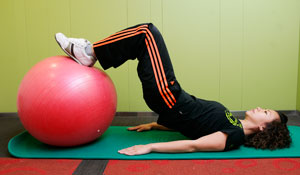
Exercise balls can be used to strengthen hamstring muscles, thus enhance the stability of one's legs.
Left: Lie flat. Place your legs on a fit ball. Slowly bend your legs and raise your lower body to pull the ball closer.
Calf muscle

Strong calf muscles, which help one to move forward and jump, can be strengthened by weight lifting equipment. Tiptoeing and standing on one feet can help improving the strength of calf muscle and the stability of ankle, thus sprains can be prevented.
Stretching exercise prevents knee pain

Repetitive movement of the knee joint will cause pain to the outer thigh muscles. To reduce friction and prevent knee pain, stretching exercise can be done.
Right: Crossed-leg stretch can help improve the flexibility of outer thighs and reduce the friction inside the knee joint.
High agility lowers the chance of injury
Contacts sports, such as rugby, involve full physical contact. Players need to jump, twist or turn around to pass a ball in response to the opponent''s attack. Only agile joints and limbs can react in time before one gets knocked down or receives a direct blow. Response training should be carried out more often so that one''s joints would get used to responding quickly whilst one''s limbs would also become more agile. This can lower the chance of injury during a game.
Protection
Proper footwear and protective gear are essential to prevent injury.
Basketball shoes
Shock-absorbing air pad in basketball shoes absorb the impact from jumping and hard running, as well as the side-to-side motions used in defense and ball handling. Most basketball shoes are high strap so to protect one''s ankles from spraining. They are also tight fitting to minimize friction.
Football shoes
For hard fields, players may wear sneaker shoes whilst football boots with studs on the bottom should be worn for grass pitches to aid grip. The materials need to be thin and flexible to allow the ankle to move in different directions. However, they should also be durable so that the shoes will not be worn out too soon. Basketball shoes are not suitable for football games because the thick materials will add pressure to the ankle that in turns leads to sprains.
Protective gear
Protective gear offers extra protection. For example, ankle brace can be worn too prevent sprains for football players whilst mouth guard protects one's teeth and chin when playing rugby. A full set of protective gear is extremely necessary in rugby games to minimize the impulsive force.
A right diet to maintain strength
A good diet with appropriate amount of nutrient also helps in preventing sports injury. Contact sports require both explosive force and endurance of muscles, so one should pay attention to the intake of carbohydrate. Other than storing carbohydrate before exercise, it is also important to replenish during exercise. For basketball players, 30 to 60 grams of carbohydrate and 250 to 500 milimetres of liquid should be intake to maintain a normal blood glucose level, as well as supplementing the water and sodium lost through sweating. Sports drinks offer quick solution in this case.
Sufficient protein, which amounts to 1.4 to 1.8 grams per each kilogram of body weights, should be consumed by athletes to enhance sports performance.
Racket Sports
Shoulder, elbow or wrist injury in the form of repetitive strain injury (RSI) or frank acute injury are common in racket sports, such as tennis, badminton or squash. Strain injury can occur in repetitive strenuous motions of the upper limbs while playing racket sports, grips the racket incorrectly, or from heavy repeated serves and smashes.
Tennis Amateurs or those who are out of practice often underestimate the physical demand it takes to play tennis. Inappropriate racket size or shape, insufficient skills and incorrect posture will easily cause strain to one’s arms. Without enough arm strength and flexibility, the risk of injury would increase.
Amateurs or those who are out of practice often underestimate the physical demand it takes to play tennis. Inappropriate racket size or shape, insufficient skills and incorrect posture will easily cause strain to one’s arms. Without enough arm strength and flexibility, the risk of injury would increase.
Tennis elbow
When playing tennis, repeated motions from ground strokes can lead to muscle fatigue of the forearm muscle tendon structures. At the same time, excessive motions from backhand stroke may cause injury to the musculotendinous structures around the elbow, leading to inflammation or tear of the tissues. Tennis elbow or lateral epicondylitis may be caused by this repetitive movement.
The racket and the skill are the two major factors that affect the chance of injury. If a racket is too heavy or of inappropriate grip size, it may easily lead to muscle fatigue. The same problem may occur when one strikes too hard, uses poor backhand technique, over stretches the dominant arm, or exercises for too long without proper resting.
With tennis elbow, one feels pain and may not be able to carry objects. The best treatment is of course rest and to avoid using the forearm muscle. Ice packs can be used to provide short-term pain relief.
Calf muscle tear
Calf muscle tear is an incomplete rupture of the inside part of the calf muscle. This muscle injury may occur as a result of a sudden contraction of the calf muscles, for instance during a sprint. Symptoms include a sudden, sharp or burning pain in the leg. It usually happens to tennis players who over-exercises or do not have sufficient warm up stretches.
Badminton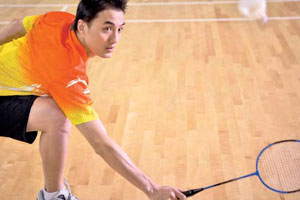 Although badminton seems relatively easy to handle in comparison to some other sports, over-doing it can also cause harm. Most of the frequent badminton injuries are from jumping and turning, causing the knee and ankle injury. Rotator cuff and the triangular cartilage of wrist injury are also common.
Although badminton seems relatively easy to handle in comparison to some other sports, over-doing it can also cause harm. Most of the frequent badminton injuries are from jumping and turning, causing the knee and ankle injury. Rotator cuff and the triangular cartilage of wrist injury are also common.
Tendon rupture
Other than tennis, badminton is another sport that would cause tendon rupture in lower limb. One of the reasons is that badminton players need to jump frequently to hit the shuttlecock, which in turns brings huge stress on the Achilles tendon. Moreover, the sudden stops and turns would also lead to dramatic changes in the contraction of the calf muscles, thereby cause tendon rupture.
Achilles tendon rupture is common among the middle aged badminton players. Tendinopathy or degeneration of tendon is common in this aged group. Sudden powerful contraction of the calf muscle from jumping or landing can easily rupture the tendon.
Rotator cuff injury
Overhead smashing is a frequently used stroke in Badminton to score points. This motion exerts great stress to the shoulder. Rotator cuff syndrome can be caused and in severe cases, the rotator cuff tendon can even be ruptured.
Wrist injury
All kinds of badminton techniques require the wrist to adjust and respond quickly. When hitting the shuttlecock from different angles, the wrist has to stretch, bend or rotate in different ways, causing pressure to wrist joint, which may harm the relatively fragile cartilage.
Squash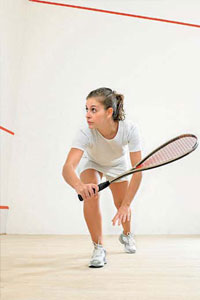 Squash is a racket sport played by two players in a four-walled court with a small, hollow rubber ball. It requires speed and explosive force like tennis, yet similar to badminton, it also needs great flexibility. So, the types of sports injuries induced by squash are very much like those faced by tennis and badminton players.
Squash is a racket sport played by two players in a four-walled court with a small, hollow rubber ball. It requires speed and explosive force like tennis, yet similar to badminton, it also needs great flexibility. So, the types of sports injuries induced by squash are very much like those faced by tennis and badminton players.
Quadriceps tendon rupture
Squash is certainly a demanding sport on the lower limbs. With limited space and high speed of the ball, one has to constantly run, jump and make sudden stops. Frequent and prolonged exercise would put excessive loads in the knees and increase the risk of strains.
Quadriceps is a powerful muscle that stabilizes the knees and allows one to make sudden stops. It is a frequently stressed muscle in squash. The muscle is often contracted in an elongated position when he knee is often bent while making sudden turns and stops. In other words, the muscle is required to contract eccentrically (in elongated position) and it can be very strenuous. Without sufficient cool down exercise, one may develop Quadriceps tendonitis, Patellar Tendonitis, commonly known as the jumper's knee. The affected area will be painful and swollen.
In the middle aged players, tendinopathy is common and rupture of the Quadriceps tendon may even occur in a violent contraction of the muscle from injury.
Elbow injury
Tennis elbow is common in squash as it also requires frequent use of the forearm muscles.
Eye injury
The limited space of squash court and the high ball speed make squash players easy victims of sports injuries. When one’s eye gets hit by a high speed squash ball, retinal or lens detachment may occur. Severe haemorrhage in the eye, if any, would affect one’s vision or even lead to blindness. Glaucoma may be developed later on if there is an increase in the intraocular pressure due to the accident.
Prevention of Racket Sports Injuries
To prevent repetitive strain injury, one should start with strengthening muscles and doing sufficient stretching exercise. Choosing the right equipment, especially the racket, is also essential. Lastly, a right diet should be followed to maintain strength.
Muscle strengthening
Swinging a racket requires shoulder joints to move and rotate in different directions. To decrease the risk of shoulder injury, one should strengthen the rotator cuff, thereby stabilizes the shoulder.
Rotator cuff training
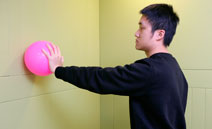
Exercise balls can be used to improve the stability of shoulder muscles. Only with strong rotator cuff can one control an exercise ball freely.
Above: Using wall resistance, press one arm against a ball. Move the ball from top to bottom and from left to right. Shoulders should be kept straight and the rotator cuff muscles should be tightened.
Stretch to enhance flexibility

Shoulder stretching prevents sprains and allows one to swing the racket smoothly.
Left: Gently pull on the right/ left forward elbow with other hand until stretch is felt in the shoulder.
Strengthen muscles to prevent injury
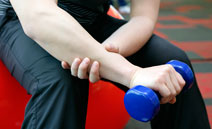
To prevent muscle fatigue, one should use correct grip on the racket to strike a ball. Other preventive measures include an optimum amount of exercise, sufficient rest and improved tendon flexibility.
Wrist flexion and extension exercise can help prevent sprains. Dumbbells can be used to train up and strengthen arm muscles, enhancing the stability of the joints when playing racket sports.
Keep right/ left elbow at side with hand holding a weight. Tilt the wrist in upward and downward motion. This exercise helps strengthening your arm muscle thus lower the risk of sprains.
Leg tendon stretch

Daily stretching exercise can be practiced to prevent injury from jumping and making sudden turns and stops.
Right: When stretching, one should stand with front leg bent and lean into wall until stretch is felt in calf. The position should be held for 15 seconds. Repeating this exercise would help muscles and tendon to relax.
Balance training helps prevent sprains

Lack of balance is one of the reasons that cause muscle sprains and tears. With frequent exercise that improves balance ability, one can avoid falling when playing sports. This would help to lower the risk of sprains.
Left: To train up the balance ability calf muscles and joints, one can do single leg stance on soft surface as exercise.
Proper equipment
Proper equipment is the key to prevent accidents. Rackets, especially for tennis, should be selected with appropriate fitness level, skills and playing habit. In general, one should choose a light racket with thin grip and large striking surface. Heavy rackets should only be used by advanced player with good arm muscles.
A proper pair of sports shoes can protect the feet and ankles. Since racket sports involves a lot of side-to-side movement, one should wear shoes that offers stability to prevent sprains and allows one to make sudden stops safely. When playing squash, light-coloured clothes should be worn to allow easy vision of the coming ball. In order to prevent serious eye injuries, players are recommended to wear eye protection gears.
Prevent muscle cramps by drinking water
Never underestimate the energy consumed when playing racket sports. For each hour of tennis game, there is 2.5 liters of water loss. Dehydration not only causes fatigue, but also leads to calf muscle cramps. To prevent muscle cramps, one should take 120 milliliters to 240 milliliters of liquid during the game. Sports drink can be consumed after the game to supplement the water and sodium lost through sweating.
Carbohydrate enhances performance
An optimal amount of carbohydrate, which is 1 gram to 4 grams per each kilogram of body weight, should be consumed three to four hours prior to a game. For instance, a man that weights 70 kilograms should consume 79 grams to 280 grams of carbohydrate, which amounts to one plate of rice. It is also important to replenish carbohydrate during exercise. The amount should be 25 grams to 30 grams of carbohydrate every half an hour. This can be done by eating one banana or drinking 500 milliliters of sports dink. Half an hour after the game, one should intake 400 calories of food to help the body to recover. The meal should include 100 grams of carbohydrate and food with high glycemic index (GI), such as two jam sandwiches.
Golf Injuries
The three basic golf motions, i.e. take away, down swing and follow through, require unnatural and complicated arc movements of one''s neck, shoulders, arms and lower back. Most injuries occur in the down swing motion.
Golf 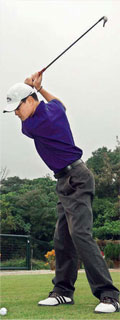 In general, professional golfers suffer from chronic hand fatigue injuries due to the repetitive strain upon the muscles, tendons or ligaments, while amateurs are more likely to be injured acutely in the wrist and the lower back.
In general, professional golfers suffer from chronic hand fatigue injuries due to the repetitive strain upon the muscles, tendons or ligaments, while amateurs are more likely to be injured acutely in the wrist and the lower back.
Shoulder injury during the swing
The "take away" and "down swing" motions require co-ordination of the shoulders and various muscle groups. Amateur golfers may injure the muscles around shoulders if their joints and muscles are not kept stable while making a full swing. Due to improper posture or technical mistakes, the golfer may hit the grass with the club, which can tear the shoulder muscles or even dislocate the shoulder joint in the process.
Arms Suffer when Hitting the Ground
Even professional golfers may miss the ball and hit the ground. Besides possible shoulder injury, the force of hitting may affect the tendons and ligaments in the arm and cause serious contusion.
Sophisticated golf players are not exempt from muscle, tendon and ligament fatigue due to repeated swinging practice, during which the whole body is strained, concentrating all the force upon the wrist. The finger joints and tendons may also be injured. "Trigger Finger" may be caused by repeated club grip and swings.
Repetitive Motions Injure Elbows
Repeated swings demand repetitive muscle extension and contraction. Together with the swinging speed and force, this repetitive motion can cause inflammation in the tendon of the medial epicondyle of the humerus at the elbow joint, or as commonly named Golfer''s Elbow. There may be a pressing pain in the affected area, and lifting heavy objects or twisting a towel will be extremely painful.
8-Time Force Strains Waist
A golf swing creates a compression force 8 times one''s body weight on the back. With constant muscle –strengthening practice, professional golfers are less prone to lower back injury. Amateurs and aged players, if without adequate warm-up, might be more susceptible to the injury for their less flexible lower back muscle. In fact, a swing is not only about brute force. If one makes a swing in wrong fashion, one''s muscle might get sprained or, in severe cases, invertebral disc herniation might occur. If one keeps acting on just one side of the body while making repeated swings, the compression may just concentrate upon one side of the vertebral joints at the back. Constant compression will twist and press against the vertebral column and result in serious fatigue. Degenerative diseases or sciatica may also occur.
Aged Players are Prone to Knee Injuries
While golf involves less movement of the lower limbs, the elderly players are at higher risk of soft tissue and ligament injuries in the knee joints. Due to their deteriorating knee caps, less stable muscles and less flexible tendons or ligaments, aged players might not be able to withstand the torque created by swinging.
Prevention of Golf Injuries
With a good musculoskeletal system, professional golfers usually focus upon the prevention of upper limb and back fatigues to protect themselves from golf-related injuries. For amateur players, the best protection comes from manifold approaches.
All-round Approach as Basic Protection
Playing in the open area directly under the sun, golfers are at a greater risk of getting sunstroke, freckles or sunburns. Golfers is advised to wear a wide-brimmed cap, long-sleeved clothes and sunscreen cream while playing in the open area of a golf course. Drinking adequate water is a must.
Beware of anyone standing nearby while swinging the club. When watching someone playing on the practice ground, golfers should protect themselves from being hit in the head by heeding the warning line at the rear area of the driving range.
Stabilizing the back - Strengthening Deep Core Muscle Fibers
As basic protection and safety measures, golfers must train the body to avoid fatigues caused by wrong postures and repeated motions. Daily exercises are crucial to strengthen the deep core muscles in the back.
Lie on the floor and bend your legs. Contract the lower abdominal and pelvic floor muscles. Breathe normally and evenly for 10 seconds, and then relax. Repeat the same cycle for 10 times. You can feel the contraction by placing your hand on the lower abdomen while contracting. These deep core muscles act like a brace t to protect the spine and balance the lumbar vertebrae.
Increased Flexibility Relieves Back Pain

Most people have a rigid thoracic vertebrae and tensed muscle groups at the back of the shoulder. As a result, they have to rotate their lumbar spine more extensively to make a good swing, which puts them at higher risk of lumbar spine injury.
(Right) Hold the golf club horizontally behind your back. Turn your upper body slowly from right to left, and vice versa. Relax the the joints between the upper and lower back. 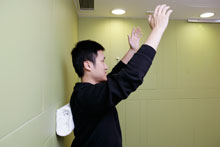
(Above) Stand against the wall. Place a towel at the thoracic spine. Stretch your shoulders and arms backwards to extend the tensed thoracic spine and chest muscle.
Strengthened Arm Muscles Reduce Injuries from Repetitive Motions

To professional golfers, tendons at the elbows are prone to fatigue due to repeated forceful swings. Amateurs may even suffer "golfers' elbow" or "tennis elbow" for they may strain their arm muscles in a wrong manner or have much weaker tendons. Regarding the best protection against these kinds of fatigues, golfers must strengthen the elbow tendons and maintain their flexibility.
(Right) Hold a dumbbell of appropriate weight with your palm facing downwards. Then slowly lift your wrist several times so as to strengthen the muscles on the dorsal side of the elbow. You can also train the muscles on the palmer side by lifting a dumbbell with your palm facing upwards.
(Below) Straighten your arm with the hand facing forward. Stretch the extended hand backward with the other hand. You can relax the muscle groups in your forearm by repeating the stretching with the hand pointing downwards. 
Grasp an elastic ball with your fingers and then relax. Repeat the action to train the elbow tendons.
Accessories can Add to Protection

Golfers can wear protective gloves while practicing swings to stabilize the elbow tendons with reduced stretching. Kinesiotex Taping can also be applied on the injured area to strengthen and adjust the muscles, ligaments and tendons. This elastic, waterproof tape allows ventilation, thus not affecting the players' performances.
High-Speed Sports Injuries Injuries caused by high-speed sports are in general more severe. Though technically demanding, in recent years high-speed sports such as skiing and water skiing have become popular pastimes among most Hongkongers.
Injuries caused by high-speed sports are in general more severe. Though technically demanding, in recent years high-speed sports such as skiing and water skiing have become popular pastimes among most Hongkongers.
Tendons Twisted and Torn Apart due to Locked Lower Limbs
In recent years, many Hongkongers choose to ski in foreign countries during the Christmas season. It is the only time during which they can ski each year. As most of them are just novice skiers, it means they cannot get enough practice and are thus more prone to sports-related injuries. According to a research, a skier, whether experienced or not, would be injured once every 400 hours of skiing.
The knee caps bear the whole bodyweight when the skier leans forward while skiing, straining the knee joints. With the limbs "locked" in the ski boots with the skis, the knees might fall inwards when the skier is losing balance. High speed and brute force would twist the cruciate ligaments in the knee joints, tearing the medial collateral ligament and anterior cruciate ligament apart. Sometimes the impact may even pull the meniscus and cartilages. The thumbs of the skier may also get stuck with the pole while falling, which makes the medial collateral ligaments snap or the bones fracture instantly (Skier''s Thumb). When one tries to protect oneself by opening the arms, the wrists and shoulder joints may fracture or dislocate to varying extents.
Also a dangerous sport like skiing, snowboarding is probably riskier in terms of severity and frequency of injury. On average one accident occurs in every 200 hours of snowboarding, and such injury may cause damage to the head, neck and spine, or even result in death.
Losing Balance and Falling into the Water - The Cause of Open Fracture
Wearing a safety jacket, most water skiers think it is nothing but a dive when they lose balance while waterskiing. The dire truth is that waterskiing is far more dangerous than snow skiing. Water skiers are the most vulnerable at the start, during the action they must maintain balance at high speed. If they fail to stand with balance in time and step into the water instead, the body would lean forward. Still holding tight the ski rope attached to the speedboat, the hands of the skiers would be stretched at high speed, thereby injuring the shoulders and causing muscle strains and joint dislocation. The impact is no small crush when one falls into the water at such back-breaking speed. The skier may even suffer open fracture in case of hitting the boat.
Prevention of High-Speed Sports Injuries
While getting the hang of the techniques can minimize the risk of high-speed sports injury, enhanced body stability, coordination and agility can reduce the incidence and severity of sports-related injury.
Well Beforehand Practice Results in Optimal Preparedness  A key to prevention of skiing and water-skiing injuries is to have a well-prepared body.
A key to prevention of skiing and water-skiing injuries is to have a well-prepared body.
It is not enough just to do warm-up stretches immediately before snow skiing or waterskiing. On top of regular cardiopulmonary exercises, daily targeted practice is also necessary to fully prepare the musculoskeletal system for high-speed sports. Early practice is of particular importance to skiing, and should begin 2 to 3 months prior to the "real thing". It includes core stabilization, shoulder training, lower limb enhancement, limb coordination, etc. to strengthen one's preparedness for any kind of accidents.
Posture adjustment, i.e. standing or sitting with the head and neck, upper and lower and the back in neutral, without a crooked back and bent back, is adequate for strengthening the deep muscles. With enhanced deep core muscles, the body can move in a stable fashion rather than swinging unsteadily.
(Right) Cardiopulmonary Fitness: Practise using the Arc Trainer for half an hour or longer. Not only does it enhance the cardiopulmonary function but also it promotes limb and joint coordination as required while skiing.
 (Left) Core Stabilization and Training of Joints: Stand on unstable pads placed on a slanted surface. Act as if hitting or receiving a ball at speed and change the position swiftly while standing. This helps enhance agility and coordination.
(Left) Core Stabilization and Training of Joints: Stand on unstable pads placed on a slanted surface. Act as if hitting or receiving a ball at speed and change the position swiftly while standing. This helps enhance agility and coordination.
Lower limbs can be stabilized by strengthening those muscles for swiveling in the buttocks, the thigh muscles and the calf muscles.
(Right) Strengthen the muscles at the back of the thigh with the fitness machines. Regular training ensures the lower limbs are strongly stabilized, thereby reduce the torque acting upon the knees while skiing as well as the risk of anterior cruciate ligament injury.
High Alertness Reduces Accidents
On top of a well-prepared body, one can get the most from sports with physical fitness and high alertness. This is especially true in skiing as in just a single afternoon, skiers can easily exhaust themselves climbing the ski slopes with the bulky equipment. Most people might work very hard and stay up very late at night prior to their holidays. After a long flight, they go straight to the ski resorts and ski without rest. In case of waterskiing, as most water skiers are in their twenties, they might have stayed up the night before and then jump on the boat the very next morning. Without rest, most of them can suffer from all kinds of injuries due to fatigue.
Choosing Well-Fitting Equipment to Enhance Safety
Together with a well-prepared body, the use of proper sports equipment and an understanding of the safety regulations guarantee reduced risk of injury. Skiers who rent equipment at ski resorts must pay attention to the skis' length and the ski boots' size. Skis that are too heavy or too long would be a tiresome burden to skiers, and ill-fitting ski boots would rub against the soles and give rise to warts.
Skiers must also provide the staff at skiing resorts with accurate information on their skiing levels and other important matters, so that the staff can cater to the needs of different users. The skis and ski boots should be easily taken off to be taken off, thereby reducing the risk and severity of anterior cruciate ligament tear in the knee joints when the skier should trip and fall.
Starting from the Less Sharply Inclined Slope
The first rule of thumb in sports injury prevention is strict adherence to safety regulations, and it is particular true in skiing. Engaging in high-speed sports on steep slopes demands exceptional skills. Skiers should know better about themselves and choose the appropriate gradient. Beginners should ski on flatter slopes (Beginners Slope), and try the steeper ones only with enough practice and in the company of a professional coach. Never ski outside the safety zones.
Even sophisticated skiers should start skiing on less inclined slope to enable the heart to adapt to the areas of high altitude and cold temperature.
Safety First
Water skiers should ski in the safe waters rather than shallow areas. Beware of the speed limit zones and keep a safe distance from other boats. Also the boat must not be overloaded. Whenever a water skier falls or is getting onboard, stop the engine. Water skiers must wear safety jackets and check all the equipment beforehand. This can minimize the risk of injury by shifting the core of the body to maintain flexibility even after falling into the water. It would add to protection if the skiers can communicate with the boat pilot using hand signals.
Foot-related Sports Injuries  Foot and ankle injuries are common in sports either in the form of acute injury or in the form of chronic repetitive injury. Foot and ankle injuries are particularly common in sports such as hiking, distance and marathon running, and sprinting that require repetitive motion of the foot and ankle. Basically any sports that place stress on the foot and ankle can potentially cause injury to the foot and ankle.
Foot and ankle injuries are common in sports either in the form of acute injury or in the form of chronic repetitive injury. Foot and ankle injuries are particularly common in sports such as hiking, distance and marathon running, and sprinting that require repetitive motion of the foot and ankle. Basically any sports that place stress on the foot and ankle can potentially cause injury to the foot and ankle.
Sprained Ankle
If not stable, the ankle might not be able to withstand the explosive force during sprinting and result in being sprained. In this situation the heel and ligaments might be overstretched, partially torn or even ruptured.
Stress Fracture
While running, especially in sprinting events, every up and down motion obliges the bone to hit the ground. The strain thus generated might cause stress fracture in the phalanges (toe bones).
Reduced Arch
Located at the bottom of the feet, an arch renders shock absorption and pressure relief. The arch becomes flatter whenever the sole is pressed. To those with flat foot, long-distance running or hiking might not only exacerbate their conditions but also injure the surrounding ligaments and tissues. With the arch being less capable of absorbing the impact while walking, one''s feet would get tired easily and even injured during sports activities.
Plantar Fasciitis
Change in weight bearing between the heel and the front leg would stretch the plantar ligaments, causing plantar fasciitis.
Hyperosteogeny
Repeated ankle movements might induce hyperosteogeny (excessive bone formation) in the conjoining Achilles tendon and affect the stretching ability of the ankle.
Injured Tendons Achilles tendons support the weight of the whole body. They might be weakened or incur inflammation if repeatedly stretched while hiking and long-distance running, as well as overly exerted while sprinting. The tendons in the area 2-3 inches above the calcaneus are particularly vulnerable to pressure due to its limited blood supply. They are prone to tears caused by the strain exerted upon them while running.
Muscle Spasm
Calf muscles would get fatigued and taut during repeated leg movements. If dehydrated, the calf muscles and tendons might get into convulsions and spasms, which in turn cause overstretching and injury. Patellar Degeneration
Whether it is walking or running, the knee joints must be bent and stretched in succession. Long-term compression and rubbing might cause fatigue and degeneration of soft tissues. Symptoms include taut iliotibial band of the lateral thigh, inner thigh muscle fatigue, pain and rubbing sound in the patellar and femur.
Overstretched Waist and Buttocks
To those carrying heavy backpacks for a long time while hiking, their lumbar and hip joints are bound to bear the extra loads and incur stretch injury under strain.
Prevention of Foot-related Sports Injuries
預防腳部運動創傷,首要是強化下肢肌肉,增加其肌力及耐力;運動後,亦應注意肌肉及肌腱伸展,有助減低過勞或繃緊;膝足關節的保護裝備及碳水化合物的補充亦不可缺少。
Training Heart and Lung - Building Up Endurance
Hiking and marathons are endurance sports. They demand excellent cardiopulmonary function and muscle endurance. Endurance training is more than just weight bearing. It emphasizes repetition and duration.
Correct Posture Protects the Back

Proper walking postures demand limb stability. That is why strong back muscle and abdominal muscle can act as a natural brace to stably wrap around the lumbar spine, thus minimize unnecessary wavering of the upper body. The muscles can also reduce the strain upon the back. Remember to walk upright and contract the abdomen without being crooked.
(Above) Kneel on the ground. Put your hands down and apart about the width of your shoulders. Keep the head, neck, waist and back at the same level. Contract the abdominal muscle, then slowly lift and straighten the left leg. At the same time extend the right arm forward. Keep the posture for a few seconds and then relax. Repeat with the other limbs.
Toe Training Helps Strengthen the Muscles and Protect the Arch  Those who are prone to the conditions of flat foot are further deprived of shock absorption and pressure relief. The risks of plantar fasciitis and fatigue fracture in the arch are thus increased as they walk on the hard surface of cement roads everyday. Besides wearing arch-supporting and shock-absorbing pads, one should also strengthen the muscles in the middle of the sole through training. This helps arch protection and relieves compression.
Those who are prone to the conditions of flat foot are further deprived of shock absorption and pressure relief. The risks of plantar fasciitis and fatigue fracture in the arch are thus increased as they walk on the hard surface of cement roads everyday. Besides wearing arch-supporting and shock-absorbing pads, one should also strengthen the muscles in the middle of the sole through training. This helps arch protection and relieves compression.
Use the big toe to pick up marbles or small objects on the ground.
Strengthening the Calf to Reduce Ankle Fatigue
Full ankle protection means extra stability to the arch. With strong calf muscles at the back, one can reduce the wavering of the ankle joints while running and prevent fatigue-related injuries. Eccentric exercise training is a good choice.
(Right) Step on a platform. Stand tiptoe. Slowly lower the ankle until the calf feels slightly stretched
Half Squat Strengthens the Thighs
Eccentric exercise training of the thigh muscles can enhance knee cap protection.
(Below) Place a fit ball behind your back. Stand straight. Keep your legs apart as wide as your shoulders, and make sure the knee caps are not in front of the tips of your feet. Keep the patellar forward and the slowly lower the whole body until half squat. (fig.3)
Thigh Stretching Prevents Patella Tendonitis
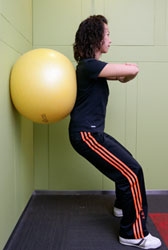
To protect against patella tendonitis and impairment of patellar tendons, one can enhance muscle flexibility and reduce strain upon the patellar by stretching the thigh muscles.
(Right) Extend one arm and place the hand on the wall. Stand straight. Grasp the ankle and slowly bend the leg backwards.
Stretching Your Muscles at the back of the Thigh Increases Stride

Short-distance runners can make big strides only with flexible muscle at the back of the thigh and strong muscle power to support the strides. They might be injured in case of improper exertion and overstretching. Frequent stretching exercises of the muscles at the back of the thigh can prevent muscle tear during sprinting.
(Below) Put a leg on a bench. Keep the back straight. Bend the hip joints.
Warm-ups Wakes Up the Body

Sprinting is all about the split-second energy upsurge, which makes warm-up particularly important to sprinters before running. Warm-up exercises usually take about 30 minutes so as to prepare the body, enhance sports performance, and most importantly, avoid sports injuries.
- Jogging raises body temperature, enhances muscle coordination and increases muscle flexibility.
- Stretch the tendons of the upper limbs, lower limbs and trunk
- Warm-up exercises for specific body parts, e.g. swinging the hands or making strides in an ever-increasing extent.
Accessories Protects the Feet
In any short-distance running, speed counts. Runners can better grasp the surface by wearing light spiked shoes. For long-distance runners, it is all about endurance and resistance to compression. That is why the soles of their footwear must be made of shock-absorbing and compression-resistant materials. To trek the treacherous lanes in the hills, hikers should wear friction-reducing and shock-absorbing shoes. There must be extra room in the shoe anterior as the feet might suffer from edema during long-distance hiking.
Wearing kinesiotex taping can support the muscles and tendons while running, strengthening the knee caps and calf muscles. Those with knee pain or having just recovered from related injuries should wear knee pads to provide further support.
Smart Eating Provides Energy
Marathons, trailwalkers and hiking are all sports of long duration. Participants should consume food containing 4 to 6g of carbohydrates per kg of bodyweight 2 to 3 days prior to the event. This not only increases the body's energy reserve but also enhances one's endurance, delaying fatigue and minimizing the risk of injury.
Participants should consume food containing 1 to 4 g of carbohydrates per kg of bodyweight within 1 to 4 hours beforehand. 30 to 60 g of carbohydrates per kg of bodyweight is necessary for every hour of intensive exertion. It is roughly equivalent to the energy content of two pieces of fruit and a bun. 1.5 g of carbohydrates per kg of bodyweight should be consumed within 30 minutes and every 2 hours after sports.
Flexibility Exercise Injuries
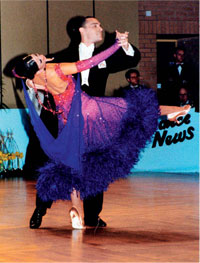 In recent years, exercises such as yoga and dancing have become quite popular among women because they can relieve stress and shape up the bodies. These exercises have their potential risk of injuries.
In recent years, exercises such as yoga and dancing have become quite popular among women because they can relieve stress and shape up the bodies. These exercises have their potential risk of injuries. Complicated Movement – Injuries Occur while over-Stretching
Yoga demands a certain degree of co-ordination between the tendons, ligaments and joints, and in particular their flexibility. Most novices, however, do not recognize the importance of warm-up exercises. Without adequate practice or good body condition, those who lack warm-ups are more easily given to injuries while stretching their rigid tendons, taut ligaments and worn-out joints. Out of vanity some of them might think too highly of themselves and try out those motions well beyond their capacities. Without exception, most of them end up with all kinds of injuries.
Fortunately, common yoga-related injuries are not that severe. Regarding those who felt unwell while practicing Bikram Yoga, most of them already are cardiovascular cases. Other common injuries include strained tendons of the hip and knee joints, which are attributable to the lotus pose.
Jump and Turn – Sore Waist and Aching Back
Nowadays, dancing is a popular pastime among middle-aged women, who have weak waists and knee joints. Without much exercises, they might not be able to catch up with all the twists and turns while dancing. The back and knee joints are particularly vulnerable when they dance to the fast music in quick sequences.
Whether it is social dance or Latin dance, dancers must wear high-heeled shoes to do all the swift turns. If not proficient in the steps or losing balance, they might suffer from strained ankle ligaments or bone fracture. Most of them would take a short break as soon as the back and waist feel pain or the knees swell to avoid any serious injury.
To those hip-hop lovers, however, it is another story. While they are nimble in mind and swift in action, all the challenging twists and turns of hip-hop mean a greater risk of injury. Professional dancers are particularly vulnerable to the knee joint ligaments tear or hind calf muscle tear when they jump, bend and make swift turns.
Prevention of Flexibility Exercise Injuries
Deep abdominal muscle training is crucial to the prevention of yoga- and dance-related injuries. It helps stabilizes the core of the body and enhance limb flexibility, thus maintaining balance during all the turns, jumps and moves. It also minimizes the risk of sprain and back pain.
Do It Step-By-Step
Solid basic training is what makes yoga and dancing look deceptively graceful and relaxed. Beginners should learn them step-by-step. Even after a period of practice, yoga practitioners and dancers must take heed of their body conditions and refrain from trying any challenging moves beyond their capacity.
Understand the Deep Muscles
For all the gracefulness, stability and safety, the control and coordination of muscles are of utmost importance. It all depends on stabilizing the muscles in the joints, e.g. deep muscles in the abdomen and the back, the inner thigh muscles, the muscles in the buttock, etc. Before practice, one should better understand one's muscle control.
(Left) Core-stabilisation Exercises
While sitting, keep your chest up and pull your abdomen in with the pelvic bone as pivot. Contract the pelvic floor muscle simultaneously until you feel the spine is stretched straight.
Strengthen the Inner Thigh Muscles To maintain balance while swiveling, dancers must strengthen the inner muscles of the thigh. Strong inner thigh muscles also reduce the risk of knee joint injury caused by excessive swinging. The outer muscles are in general stronger than the inner ones, and it means the knee caps are prone to being pulled out by the uneven distribution of muscle force and causing pain. With enhanced thigh muscles, dancers can swivel in a stable fashion.
To maintain balance while swiveling, dancers must strengthen the inner muscles of the thigh. Strong inner thigh muscles also reduce the risk of knee joint injury caused by excessive swinging. The outer muscles are in general stronger than the inner ones, and it means the knee caps are prone to being pulled out by the uneven distribution of muscle force and causing pain. With enhanced thigh muscles, dancers can swivel in a stable fashion.
(Right) Strengthening core- Muscle and Muslces in the inner thigh. Stand against a wall with the pelvic bone as pivot. Straighten the upper body, then slowly move upwards and downwards while the lower body remains in a half-squat position. Make sure the knees face forward and stay behind the toes so as to strengthen the inner thigh muscles.
Enhance flexibility by Stretching Tendons Yoga consists of various stretching movements. Dancing is also about wide-ranging swiveling motions. To avoid injury, dancers and yoga practitioners must first enhance the flexibility of different muscles, tendons, ligaments and joints before stretching the limbs during practice. Also do not be late for lessons or one may miss the warm-up stretching.
Yoga consists of various stretching movements. Dancing is also about wide-ranging swiveling motions. To avoid injury, dancers and yoga practitioners must first enhance the flexibility of different muscles, tendons, ligaments and joints before stretching the limbs during practice. Also do not be late for lessons or one may miss the warm-up stretching.
Try not to stretch in hurry and start slowly. Rest for a while after finishing each set of stretching exercises. One should feel more at ease as the muscle, tendons or ligaments become more elastic and flexible after each set of exercises. On the contrary, one should take a rest if one feels tight and painful, which implies tissue fatigue and injury.
Consult Doctor without Delay
Do not ignore any stretching injury or unusual symptom caused by flexibility sports. Without immediate medical attention, even a minor injury can deteriorate into severe problems, e.g. those who sprained the neck during yoga may have injured not only the muscles but also the cervical vertebrae and intervertebral discs, which can cause severe pain in the neck, or even hand pain and numbness.
Balanced Diet Provides Energy
On top of an excellent musculoskeletal system, balanced diet is also important for injury prevention. For a slim bodyline, most female dancers or yoga practitioners may refrain from eating too much, sometimes even go on diet before performance or practice. Emphasizing flexibility and skills with a moderate amount of exercise, sports like yoga and dancing are efficient fat burns. One can easily attain a good body shape by i) eating in small quantities each time and more frequently; and ii) consuming low-fat, low-sugar and high-fiber food. A balanced diet can also provide energy to enhance one's performance and delay fatigue, which in turn reduces the chance of sprain and fall. Athletes should be on diet only before and after competition season so as to lose extra weight without interfering with their performances.
Remember to do the stretching exercises before yoga practice or dancing.

